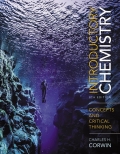
(a)
Interpretation:
The equilibrium constant expression for the following reaction is to be stated.
Concept introduction:
In a
(b)
Interpretation:
The equilibrium constant expression for the following reaction is to be stated.
Concept introduction:
In a chemical reaction, when the rates of both forward and reverse reaction are equal, then the chemical reaction is said to be at equilibrium. They are reversible in nature. The equilibrium constant is denoted as
(c)
Interpretation:
The equilibrium constant expression for the following reaction is to be stated.
Concept introduction:
In a chemical reaction, when the rates of both forward and reverse reaction are equal, then the chemical reaction is said to be at equilibrium. They are reversible in nature. The equilibrium constant is denoted as
Want to see the full answer?
Check out a sample textbook solution
Chapter 16 Solutions
EBK INTRODUCTORY CHEMISTRY
- Write the acid ionization constant expression for the ionization of each of the following monoprotic acids. a. HCN (hydrocyanic acid) b. HC6H7O6 (ascorbic acid)arrow_forwardWrite the chemical equation and the expression for the equilibrium constant, and calculate Kb for the reaction of each of the following ions as a base. (a) sulfate ion (b) citrate ionarrow_forwardWrite the acid ionization constant expression for the ionization of each of the following monoprotic acids. a. HF (hydrofluoric acid) b. HC2H3O2 (acetic acid)arrow_forward
- Write the base ionization constant expression for the ionization of each of the following bases. In each case, the nitrogen atom accepts the proton. a. CH3NH2 (methylamine) b. C2H5NH2 (ethylamine)arrow_forwardWhat is the freezing point of vinegar, which is an aqueous solution of 5.00% acetic acid, HC2H3O2, by mass (d=1.006g/cm3)?arrow_forwardFor each of the following salts in water, predict whether the pH will be greater than, less than, or equal to 7. (a) KBr (b) NH3NO3 (c) AlCl3 (d) Na2HPO4arrow_forward
- . Write the conjugate base for each of the following acids. a. HBrO b. HNO2 c. HSO3 d. CH3NH3+arrow_forwardTable 13-4 lists the stepwise Ka values for some polyprotic acids. What is the difference between a monoprotic acid, a diprotic acid, and a triprotic acid? Most polyprotic acids are weak acids; the major exception is H2SO4. To solve for the pH of a solution of H2SO4, you must generally solve a strong acid problem as well as a weak acid problem. Explain. Write out the reactions that refer to Ka1 and Ka2 for H2SO4. For H3PO4, Ka1 = 7.5 103, Ka2 = 6.2 108, and Ka3= 4.8 1013. Write out the reactions that refer to the Ka1, Ka2and Ka3equilibrium constants. What are the three acids in a solution of H3PO4? Which acid is strongest? What are the three conjugate bases in a solution of H3PO4? Which conjugate base is strongest? Summarize the strategy for calculating the pH of a polyprotic acid in water.arrow_forwardWrite chemical equations showing the individual proton-transfer steps that occur in aqueous solution for each of the following acids. a. H2C2O4 (oxalic acid) b. H2C4H4O6 (tartaric acid)arrow_forward
 General, Organic, and Biological ChemistryChemistryISBN:9781285853918Author:H. Stephen StokerPublisher:Cengage Learning
General, Organic, and Biological ChemistryChemistryISBN:9781285853918Author:H. Stephen StokerPublisher:Cengage Learning Chemistry for Today: General, Organic, and Bioche...ChemistryISBN:9781305960060Author:Spencer L. Seager, Michael R. Slabaugh, Maren S. HansenPublisher:Cengage Learning
Chemistry for Today: General, Organic, and Bioche...ChemistryISBN:9781305960060Author:Spencer L. Seager, Michael R. Slabaugh, Maren S. HansenPublisher:Cengage Learning Chemistry for Engineering StudentsChemistryISBN:9781337398909Author:Lawrence S. Brown, Tom HolmePublisher:Cengage Learning
Chemistry for Engineering StudentsChemistryISBN:9781337398909Author:Lawrence S. Brown, Tom HolmePublisher:Cengage Learning Introductory Chemistry: A FoundationChemistryISBN:9781337399425Author:Steven S. Zumdahl, Donald J. DeCostePublisher:Cengage Learning
Introductory Chemistry: A FoundationChemistryISBN:9781337399425Author:Steven S. Zumdahl, Donald J. DeCostePublisher:Cengage Learning Chemistry: Principles and PracticeChemistryISBN:9780534420123Author:Daniel L. Reger, Scott R. Goode, David W. Ball, Edward MercerPublisher:Cengage Learning
Chemistry: Principles and PracticeChemistryISBN:9780534420123Author:Daniel L. Reger, Scott R. Goode, David W. Ball, Edward MercerPublisher:Cengage Learning





